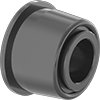Filter by
Color
Shape
Thickness
Thread Size
Mount Type
Hardness
Maximum Temperature
Finish
Mounting Hole Diameter
Plain Bearing Type
Performance
DFARS Specialty Metals
Minimum Temperature
Fastening and Joining
Building and Machinery Hardware
Power Transmission
Electrical
Material Handling




















































